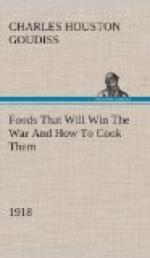Beef or mutton (5 to 8 lbs.) 10 min. to the lb. 10 min. extra Lamb (5 to 8 lbs.) 12 min. to the lb. 12 min. extra Veal (5 to 8 lbs.) 15 min. to the lb. 15 min. extra Pork (5 to 8 lbs.) 25 min. to the lb. 25 min. extra Turkey 20 min. to the lb. Chicken 30 min. to the lb. Duck 30 min. to the lb. Goose 30 min. to the lb. Game 30 min. to the lb.
2. Broiling—Cooking over or under clear fire. This method is used for chops or steaks.
Sear the meat on both sides. Then reduce the heat and turn the meat frequently. Use no fat.
Time Table—(Count
time after meat is seared).
1/2 inch chops or steaks, 5 minutes
1 inch chops or steaks, 10 minutes
2 inch chops or steaks, 15 to 18
minutes
3. Pan Broiling—Cooking in pan with no fat. Time table same as for broiling chops, steaks, etc.
4. Sauteing—Cooking in pan in small amount of fat. Commonly termed “frying.” Used for steaks, chops, etc. Time table same as for broiling.
MOIST METHODS
1. Boiling—Cooking in boiling water—especially poultry, salt meats, etc.
2. Steaming—A method of cooking by utilizing steam from boiling water, which retains more food value than any other. Too seldom applied to meats.
3. Frying—Cooking by immersion in hot fat at temperature 400 to 450 degrees Fahrenheit. Used for croquettes, etc.
If a fat thermometer is not available, test by using small pieces of bread. Put into heated fat:
A—For croquettes made from food requiring little cooking, such as oysters, or from previously cooked mixtures, as rice, fish or meat croquettes, bread should brown in one-half minute.
B—For mixtures requiring cooking, as doughnuts, fritters, etc., bread should brown in one minute.
COMBINATION METHODS
1. Pot Roasting—Cooking (by use of steam from small amount of water) tough cuts of meat which have been browned but not cooked thoroughly.
Season meat. Dredge with flour. Sear in hot pan until well browned. Place oil rack in pot containing water to height of one inch, but do not let water reach the meat. Keep water slowly boiling. Replenish as needed with boiling water. This method renders tough cuts tender, but requires several hours cooking.
2. Stewing—A combination of methods which draws part of flavor into gravy and retains part in pieces which are to be used as meat.
Cut meat into pieces suitable for serving. Cover one-half of meat with cold water. Let stand one hour. Bring slowly to boiling point. Dredge other half of meat with flour and brown in small amount of fat. Add to the other mixture and cook slowly 1-1/2 to 2 hours, or until tender, adding diced vegetables, thickening and seasoning as desired one-half hour before cooking is finished.




